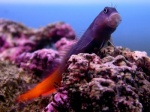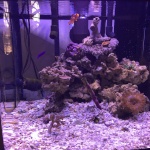Has anyone tried this?
5 posters
Page 1 of 1
 Has anyone tried this?
Has anyone tried this?
AIPTASIA | A METHOD OF CONTROL
(reprinted with Breefcase's permission from works written in reefs.org)
One of the most frequently asked questions on this board is how to control the unwanted growth of Aiptasia (small infesting sea anemone, Aiptasia pallida and Aiptasia pulchella, which frequently show up as hitchhikers in reef aquaria). So, I thought there might be some general interest in the chemical control method I use (described in detail below), which is fairly easy and quite effective, but which I've never seen described on the board.
I'm normally pretty tolerant of Aiptasia, since I kind of admire their level of biological adaptation and tenacity, and I find that they normally don't get too out of control in a well balanced reef. However, when a couple of them got large recently and started to annoy their other tank mates, it was time to rein in my Aiptasia a bit. The method I have developed is easy, safe when used carefully, and works pretty well.
First, here's a bit of background about what doesn't work for me. The other chemical Aiptasia control methods commonly recommended on this board typically involve using a medical hypodermic needle to inject something -- boiling water, Calcium Hydroxide (Kalkwasser) paste, or concentrated aquarium salt solution -- directly into the gastrovascular cavity of the Aiptasia. However, these methods don't give very good results for me. I've never found a means of keeping the boiling water hot enough until it could be delivered, and my Aiptasia usually decline to pose stock-still and fully expanded while I poke at them with needles -- they usually collapse into themselves, or even withdraw into a hole in the live rock, at the first approach of the needle.
Mechanical means like scrubbing with toothbrushes or burning with soldering torches or irons work somewhat, if you can get the rock or whatever out of the water, and if you can then remember where the Aiptasia are located, but these methods are of no utility in-situ.
Biological controls are also occasionally recommended on this board, and can sometimes work well -- the nudibranch Berghia verrucicornis, various Butterfly Fish including Chelmon rostratus and Chaetodon kleinii, and the Peppermint Shrimp Rhynchocinetidae sp and Lysmata wurdemanni will all sometimes eat some Aiptasia. The problem with all of these creatures is first obtaining them, and then maintaining them after they have served their purpose. All of these may eat more than just Aiptasia, too, and you may or may not want to keep them in your reef.
In contrast, the BReefCase patented Aiptasia killing method involves chemically burning the Aiptasia both internally and externally through the localized underwater application of concentrated aqueous Sodium Hydroxide solution, NaOH. The advantage of this method is that it's not necessary to actually inject the Aiptasia with the chemical -- just get the end of the applicator tube as close as possible to the Aiptasia or its hole in the rocks, and squirt a little drop of the NaOH into the water above the target. The intense boiling "heat of dilution" of the concentrated solution as it enters the tank water, coupled with the chemical burning action of the highly basic solution, kills the entire Aiptasia quite handily.
To use this Aiptasia control method in your own tank, buy some aqueous 2N ("two Normal") Sodium Hydroxide (NaOH) from your local chemical supply store (or buy it online from Southern Scientific, Science Alliance, Redbird Service, Caledon Labs, or similar mailorder supply). A liter or two should be a lifetime supply for most reef keepers.
By the way, this stuff is highly caustic and will burn you like an Aiptasia, so use common sense and keep it away from skin, eyes, mouth, kids, pets, clothes, carpets, tank stands, neighbors and etc., just as you would any other dangerous household chemical. It looks like water, so always leave it in its original plainly marked safety container. It is harmless to your reef tank once it is fully diluted -- the only caution is that using a lot of it, as when killing lots of Aiptasia, can raise the specific gravity of the tank water just like adding any other concentrated source of Sodium.
To make an applicator for this method, go to the baby supply aisle of your local grocery store and get one of those little plastic syringes used to measure liquid baby medicine. Attach a piece of small-bore rigid airline tubing, long enough to reach all over your tank, to the syringe with a short length of regular flexible airline tubing - it should be an exact fit, but if not you can use some silicone aquarium cement to attach it so long as the joint is water tight. Bend a broad radius 90 degree curve into the last four inches or so of the tube so you can sneak it around rock corners and behind heaters, power heads, or whatever.
Suck up a few milliliters of NaOH into your applicator. Temporarily turn off the pumps, power heads and any other circulation -- I just hit the "feeding button" on my wave maker -- and go kill some Aiptasia. When you squirt a tiny bit of the NaOH into the water next to an Aiptasia, there will be an intense localized chemical reaction that looks like heat waves in the water and immediately forms a white caustic chemical slurry (you'll know it when you see it). This chemical reaction and the resulting slurry will kill the Aiptasia but then quickly dissipate as it gets diluted by tank water.
Keep the slurry from settling for too long on anything you don't want to kill -- I use a little shield, made from a small square of styrene plastic glued to a handle made from another piece of that rigid airline tubing, to control where the slurry settles and to keep it off more valued critters. Stirring it around will break it up and dissipate it. You can also use another syringe loaded with tank water like a little power head to break up the slurry if it settles somewhere unwanted. Make sure to turn the tank circulation back on when you are done, to break up any residual chemical clouds and dilute them harmlessly.
You do need to be a little careful about where this stuff settles out. The last time I used this method, some of the slurry drifted onto one of my mushroom corals and I failed to notice for about a minute until the pumps came back on. The mushroom disappeared and I thought I had killed it for sure, but after it had sulked for a couple of days it reappeared and then was as good as new. But, exercise due care.
The Aiptasia killing power of this method exploits natural Aiptasia physiology. The mouth of an Aiptasia is an elongated slit in the center of the anomone's oral disk, expanded a little at each end. These expansions are the top ends of vertical, ciliated grooves called siphonoglyphs. The cilia of the siphonoglyphs generate a constant flow of water into the gastrovascular or body cavity of the anemone, even when the center opening of the Aiptasia's mouth is closed. The mouth opens into a short, flattened tube, called the pharynx. The siphonoglyphs are at opposite edges of the flattened pharynx, which in turn opens directly into the gastrovascular cavity of the anemone. The Aiptasia can't stop this flow.
So, the upshot of all this Aiptasia anatomy lesson is that the pesky little Aiptasia is ultimately going to ingest the caustic NaOH slurry we've placed on it, whether it wants to or not. This will usually kill the entire Aiptasia, including the tough pedal disk and any residual cells of the incipient pedal lacerete (the means by which Aiptasia reproduce asexually and spread). Failure to kill all parts of the organism is one reason that Aiptasia normally grow back after being treated by the other common chemical control methods used in reefkeeping.
Even with this NaOH method, which is the most effective method I've tried, about ten percent of treated Aiptasia will survive (tough little buggers!). So, for total control be sure to recheck your results after about two days, and re-treat any stubborn or well-protected or hidden Aiptasia that escaped or survived the initial treatment.
Remember that the key to the killing power of this method is getting the slurry to settle on the Aiptasia or its hole and STAY there for at least several seconds - the longer the better. If the exposure is too short, this method will not work any better than the other chemical control methods.
In tough cases you can use 3N (three Normal) NaOH, but if you do, be VERY careful where the excess 3N NaOH slurry drifts or you'll kill a lot of other things in the tank along with the Aiptasia. Be careful that using too much 3N NaOH in a small tank doesn't raise your pH suddenly just like dripping too much Kalk.
By the way, Sodium Hydroxide is also commonly available commercially as industrial drain cleaner, and is the main ingredient in household chemical drain openers like Liquid Plumber and Drain-o. This might be OK if you are lucky, but in genral you should avoid the temptation to buy your NaOH this way.
The stuff made to pour down plugged drains and into clogged toilets is way too concentrated to be used safely by hand, and can contain thickeners and other chemical agents not necessarily listed on the label, including such things as Copper Sulfate. As all reefkeepers should know, any source of ionic Copper is deadly to most marine invertebrates, and must absolutely be avoided. Buy your NaOH only as the pure certified material from a chemical supply house that will guarantee its purity and quality.
Reefscapes.net © 2002
g g g g
(reprinted with Breefcase's permission from works written in reefs.org)
One of the most frequently asked questions on this board is how to control the unwanted growth of Aiptasia (small infesting sea anemone, Aiptasia pallida and Aiptasia pulchella, which frequently show up as hitchhikers in reef aquaria). So, I thought there might be some general interest in the chemical control method I use (described in detail below), which is fairly easy and quite effective, but which I've never seen described on the board.
I'm normally pretty tolerant of Aiptasia, since I kind of admire their level of biological adaptation and tenacity, and I find that they normally don't get too out of control in a well balanced reef. However, when a couple of them got large recently and started to annoy their other tank mates, it was time to rein in my Aiptasia a bit. The method I have developed is easy, safe when used carefully, and works pretty well.
First, here's a bit of background about what doesn't work for me. The other chemical Aiptasia control methods commonly recommended on this board typically involve using a medical hypodermic needle to inject something -- boiling water, Calcium Hydroxide (Kalkwasser) paste, or concentrated aquarium salt solution -- directly into the gastrovascular cavity of the Aiptasia. However, these methods don't give very good results for me. I've never found a means of keeping the boiling water hot enough until it could be delivered, and my Aiptasia usually decline to pose stock-still and fully expanded while I poke at them with needles -- they usually collapse into themselves, or even withdraw into a hole in the live rock, at the first approach of the needle.
Mechanical means like scrubbing with toothbrushes or burning with soldering torches or irons work somewhat, if you can get the rock or whatever out of the water, and if you can then remember where the Aiptasia are located, but these methods are of no utility in-situ.
Biological controls are also occasionally recommended on this board, and can sometimes work well -- the nudibranch Berghia verrucicornis, various Butterfly Fish including Chelmon rostratus and Chaetodon kleinii, and the Peppermint Shrimp Rhynchocinetidae sp and Lysmata wurdemanni will all sometimes eat some Aiptasia. The problem with all of these creatures is first obtaining them, and then maintaining them after they have served their purpose. All of these may eat more than just Aiptasia, too, and you may or may not want to keep them in your reef.
In contrast, the BReefCase patented Aiptasia killing method involves chemically burning the Aiptasia both internally and externally through the localized underwater application of concentrated aqueous Sodium Hydroxide solution, NaOH. The advantage of this method is that it's not necessary to actually inject the Aiptasia with the chemical -- just get the end of the applicator tube as close as possible to the Aiptasia or its hole in the rocks, and squirt a little drop of the NaOH into the water above the target. The intense boiling "heat of dilution" of the concentrated solution as it enters the tank water, coupled with the chemical burning action of the highly basic solution, kills the entire Aiptasia quite handily.
To use this Aiptasia control method in your own tank, buy some aqueous 2N ("two Normal") Sodium Hydroxide (NaOH) from your local chemical supply store (or buy it online from Southern Scientific, Science Alliance, Redbird Service, Caledon Labs, or similar mailorder supply). A liter or two should be a lifetime supply for most reef keepers.
By the way, this stuff is highly caustic and will burn you like an Aiptasia, so use common sense and keep it away from skin, eyes, mouth, kids, pets, clothes, carpets, tank stands, neighbors and etc., just as you would any other dangerous household chemical. It looks like water, so always leave it in its original plainly marked safety container. It is harmless to your reef tank once it is fully diluted -- the only caution is that using a lot of it, as when killing lots of Aiptasia, can raise the specific gravity of the tank water just like adding any other concentrated source of Sodium.
To make an applicator for this method, go to the baby supply aisle of your local grocery store and get one of those little plastic syringes used to measure liquid baby medicine. Attach a piece of small-bore rigid airline tubing, long enough to reach all over your tank, to the syringe with a short length of regular flexible airline tubing - it should be an exact fit, but if not you can use some silicone aquarium cement to attach it so long as the joint is water tight. Bend a broad radius 90 degree curve into the last four inches or so of the tube so you can sneak it around rock corners and behind heaters, power heads, or whatever.
Suck up a few milliliters of NaOH into your applicator. Temporarily turn off the pumps, power heads and any other circulation -- I just hit the "feeding button" on my wave maker -- and go kill some Aiptasia. When you squirt a tiny bit of the NaOH into the water next to an Aiptasia, there will be an intense localized chemical reaction that looks like heat waves in the water and immediately forms a white caustic chemical slurry (you'll know it when you see it). This chemical reaction and the resulting slurry will kill the Aiptasia but then quickly dissipate as it gets diluted by tank water.
Keep the slurry from settling for too long on anything you don't want to kill -- I use a little shield, made from a small square of styrene plastic glued to a handle made from another piece of that rigid airline tubing, to control where the slurry settles and to keep it off more valued critters. Stirring it around will break it up and dissipate it. You can also use another syringe loaded with tank water like a little power head to break up the slurry if it settles somewhere unwanted. Make sure to turn the tank circulation back on when you are done, to break up any residual chemical clouds and dilute them harmlessly.
You do need to be a little careful about where this stuff settles out. The last time I used this method, some of the slurry drifted onto one of my mushroom corals and I failed to notice for about a minute until the pumps came back on. The mushroom disappeared and I thought I had killed it for sure, but after it had sulked for a couple of days it reappeared and then was as good as new. But, exercise due care.
The Aiptasia killing power of this method exploits natural Aiptasia physiology. The mouth of an Aiptasia is an elongated slit in the center of the anomone's oral disk, expanded a little at each end. These expansions are the top ends of vertical, ciliated grooves called siphonoglyphs. The cilia of the siphonoglyphs generate a constant flow of water into the gastrovascular or body cavity of the anemone, even when the center opening of the Aiptasia's mouth is closed. The mouth opens into a short, flattened tube, called the pharynx. The siphonoglyphs are at opposite edges of the flattened pharynx, which in turn opens directly into the gastrovascular cavity of the anemone. The Aiptasia can't stop this flow.
So, the upshot of all this Aiptasia anatomy lesson is that the pesky little Aiptasia is ultimately going to ingest the caustic NaOH slurry we've placed on it, whether it wants to or not. This will usually kill the entire Aiptasia, including the tough pedal disk and any residual cells of the incipient pedal lacerete (the means by which Aiptasia reproduce asexually and spread). Failure to kill all parts of the organism is one reason that Aiptasia normally grow back after being treated by the other common chemical control methods used in reefkeeping.
Even with this NaOH method, which is the most effective method I've tried, about ten percent of treated Aiptasia will survive (tough little buggers!). So, for total control be sure to recheck your results after about two days, and re-treat any stubborn or well-protected or hidden Aiptasia that escaped or survived the initial treatment.
Remember that the key to the killing power of this method is getting the slurry to settle on the Aiptasia or its hole and STAY there for at least several seconds - the longer the better. If the exposure is too short, this method will not work any better than the other chemical control methods.
In tough cases you can use 3N (three Normal) NaOH, but if you do, be VERY careful where the excess 3N NaOH slurry drifts or you'll kill a lot of other things in the tank along with the Aiptasia. Be careful that using too much 3N NaOH in a small tank doesn't raise your pH suddenly just like dripping too much Kalk.
By the way, Sodium Hydroxide is also commonly available commercially as industrial drain cleaner, and is the main ingredient in household chemical drain openers like Liquid Plumber and Drain-o. This might be OK if you are lucky, but in genral you should avoid the temptation to buy your NaOH this way.
The stuff made to pour down plugged drains and into clogged toilets is way too concentrated to be used safely by hand, and can contain thickeners and other chemical agents not necessarily listed on the label, including such things as Copper Sulfate. As all reefkeepers should know, any source of ionic Copper is deadly to most marine invertebrates, and must absolutely be avoided. Buy your NaOH only as the pure certified material from a chemical supply house that will guarantee its purity and quality.
Reefscapes.net © 2002
g g g g

HSCmember- Great White

- Location : Bemidji
Number of posts : 560
 Re: Has anyone tried this?
Re: Has anyone tried this?
I usually just stick to kalk, paste works best but hard depending on where they are, I've got a bunch that are super close or touching corals so I'd rather kalk 2-3x than risk killing something I like. Although on reefcentral Paul B makes a cool little majano/aip "zapper" that electrocutes them or something, not sure how well it works but sounds satisfying if nothing else. 


GoingPostal- Mod

- Location : Int'l Falls, MN
Number of posts : 1479
Age : 38
 Re: Has anyone tried this?
Re: Has anyone tried this?
I did try Aiptasia-X (works well, but tedious with even a small tank) and Joe's Juice (kills on contact, still tedious, but less expensive and plugs the syringe applicator, but you can thin it with water)
Then I got a file fish in one tank and a copperbanded butterfly in the other, and I wish I had some more aiptasia, they ate everyone too quickly. Fortunately they are eating Mysis shrimp and not my corals, SO far so good, (6 months now) I have a couple Aiptasia living in my sump, I may try to transplant for food variety. You want to borrow my fish?
Then I got a file fish in one tank and a copperbanded butterfly in the other, and I wish I had some more aiptasia, they ate everyone too quickly. Fortunately they are eating Mysis shrimp and not my corals, SO far so good, (6 months now) I have a couple Aiptasia living in my sump, I may try to transplant for food variety. You want to borrow my fish?

Nannook- Lion Fish

- Location : Weatherford Texas, but my heart in in Duluth
Number of posts : 359
Age : 65
 Re: Has anyone tried this?
Re: Has anyone tried this?
Get a filefish thay love Aiptasia for supper.

danreefs- Great White

- Location : brainerd
Number of posts : 1516
Age : 51
 Re: Has anyone tried this?
Re: Has anyone tried this?
I found what works best for me is just controlling my nutrient levels, strong detrivitors crew and low fish count in the tank, seems to work well for controlling Aiptasia,if there food supply is low they will not spread.
 Re: Has anyone tried this?
Re: Has anyone tried this?
Nannook wrote:I did try Aiptasia-X (works well, but tedious with even a small tank) and Joe's Juice (kills on contact, still tedious, but less expensive and plugs the syringe applicator, but you can thin it with water)
Then I got a file fish in one tank and a copperbanded butterfly in the other, and I wish I had some more aiptasia, they ate everyone too quickly. Fortunately they are eating Mysis shrimp and not my corals, SO far so good, (6 months now) I have a couple Aiptasia living in my sump, I may try to transplant for food variety. You want to borrow my fish?
We have 6 peppermint shrimp. Would a filefish eat them?

HSCmember- Great White

- Location : Bemidji
Number of posts : 560
 Re: Has anyone tried this?
Re: Has anyone tried this?
I've read a lot of horror stories of filefish moving onto lps corals, I want thinking about getting a pair for the fowlr, I'd be bummed if they eat all my frogspawns and torch though. Who was it on here with the aip overload? I'd risk it with that kind of an issue but not for just a few here and there. I kalked again last week, missed a couple though.

GoingPostal- Mod

- Location : Int'l Falls, MN
Number of posts : 1479
Age : 38
Page 1 of 1
Permissions in this forum:
You cannot reply to topics in this forum|
|
|

 Home
Home